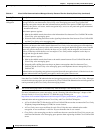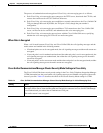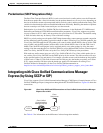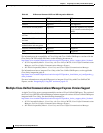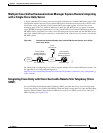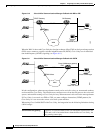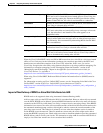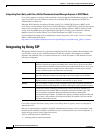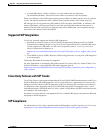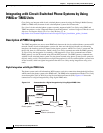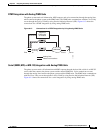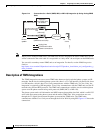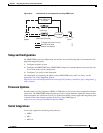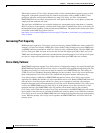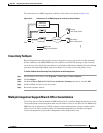
6-22
Design Guide for Cisco Unity Release 5.x
OL-14619-01
Chapter 6 Integrating Cisco Unity with the Phone System
Integrating by Using SIP
Integrating Cisco Unity with Cisco Unified Communications Manager Express in SRST Mode
Cisco Unity supports a topology with centralized call processing and distributed messaging, in which
your Cisco
Unity server is located at a remote site or branch office and registered with the Cisco
Unified
CM at a central site.
When the WAN link fails, the phones fall back to the Cisco Unified CM Express-as-SRST device.
Cisco
Unity can also fall back to the Cisco Unified CM Express-as-SRST device, which lets users at the
remote site access their voice messages and see message waiting indicators (MWIs) during a WAN
outage. Note that MWIs must be resynchronized from the Cisco
Unity server whenever a failover
happens from Cisco Unified
CM to Cisco Unified CM Express-as-SRST or vice versa.
For information on setting up this configuration, see the Integrating Cisco Unity with Cisco Unified
CME-as-SRST application note at
http://www.cisco.com/en/US/products/sw/voicesw/ps4625/prod_troubleshooting_guides_list.html.
Integrating by Using SIP
SIP (Session Initiation Protocol) is the Internet Engineering Task Force standard for multimedia calls
over IP. SIP is a peer-to-peer, ASCII-based protocol that uses requests and responses to establish,
maintain, and terminate calls (or sessions) between two or more end points. A SIP network uses the
following components:
Cisco Unity accepts calls from a proxy server. Cisco Unity relies on a proxy server or call agent to
authenticate calls.
SIP uses a request/response method to establish communications between various components in the
network and to ultimately establish a conference (call or session) between two or more endpoints. A
single call may involve several clients and servers.
Users in a SIP network are identified by:
• A unique phone or extension number.
SIP proxy server
The proxy server is an intermediate device that receives SIP requests from a client
and then forwards the requests on behalf of the client. Proxy servers receive SIP
messages and forward them to the next SIP server in the network. Proxy servers can
provide functions such as authentication, authorization, network access control,
routing, reliable request retransmission, and security.
Redirect server
Provides information to the client about the next hop or hops that a message should
take. The client then contacts the next hop server or user-agent server directly.
Registrar server
Processes requests from user agent clients for registration of their current location.
Registrar servers are often installed on the redirect or proxy server.
Phones
Can act as either a server or client. Softphones (PCs that have phone capabilities
installed) and Cisco SIP IP phones can initiate SIP requests and respond to requests.
Gateways
Provide call control. Gateways provide many services; the most common is a
translation function between SIP call endpoints and other terminal types. This
function includes translation between transmission formats and between
communications procedures. In addition, the gateway translates between audio and
video codecs, and performs call setup and clearing on both the LAN side and the
switched-circuit network side.



